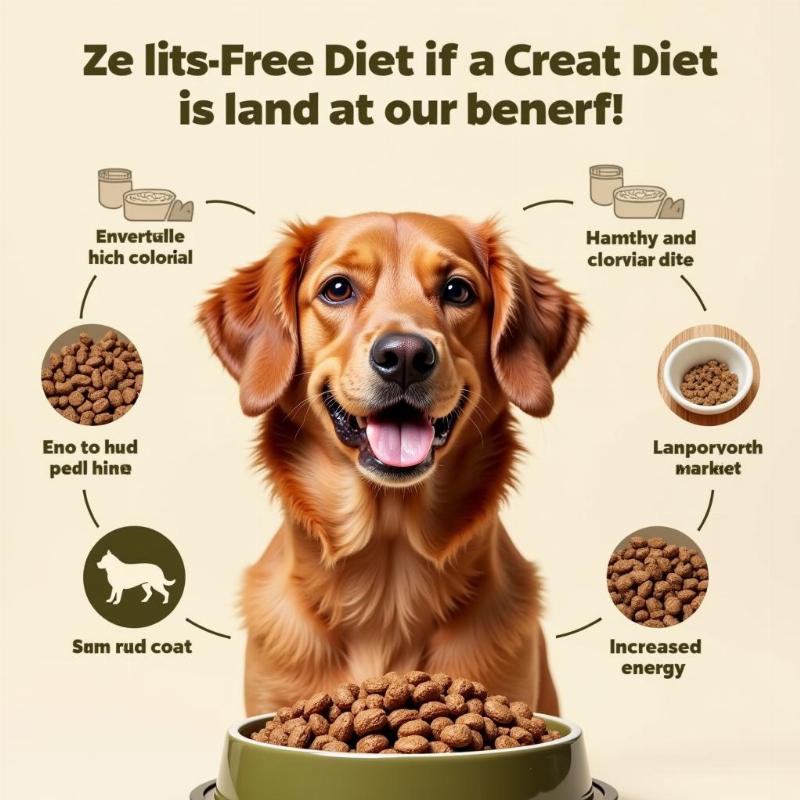Grain-free kibble has become a popular choice for dog owners in the US, promising improved digestion, healthier skin and coat, and increased energy levels. But is grain-free dog food truly the best option for every canine companion? This article dives deep into the world of grain-free kibble, exploring its benefits, potential risks, and helping you decide if it’s the right choice for your furry friend.
Understanding the Grain-Free Trend in Dog Food
The rise of grain-free dog food stems from the belief that grains are fillers with little nutritional value for dogs. While some dogs may have genuine grain allergies or sensitivities, the grain-free trend has extended beyond these specific cases. Many pet owners perceive grain-free kibble as a more natural and healthier option, aligning with human dietary trends. However, it’s crucial to understand the nuances of grain-free diets and their impact on canine health.
The Potential Benefits of Grain-Free Kibble
For dogs with grain allergies or sensitivities, switching to a grain-free diet can offer significant relief from digestive upset, itchy skin, and ear infections. Grain-free kibble often uses alternative carbohydrate sources like potatoes, sweet potatoes, or peas, providing the necessary energy without triggering allergic reactions. Some proponents also suggest that grain-free diets can improve coat health and boost energy levels in dogs, although these claims are not always scientifically substantiated.
 Benefits of Grain-Free Kibble for Dogs
Benefits of Grain-Free Kibble for Dogs
Potential Risks and Concerns with Grain-Free Kibble
While grain-free kibble can be beneficial for some dogs, it’s important to be aware of potential risks. In recent years, the FDA has investigated a potential link between grain-free diets and dilated cardiomyopathy (DCM), a serious heart condition. Although the research is ongoing, it’s crucial to consult with your veterinarian before switching your dog to a grain-free diet, especially if they have any pre-existing health conditions. Furthermore, not all grain-free kibble is created equal. Some brands may be higher in fat and calories, leading to weight gain if not properly portioned.
Choosing the Right Grain-Free Kibble for Your Dog
If you decide to explore grain-free options, it’s essential to choose a high-quality kibble that meets your dog’s specific nutritional needs. Look for brands that use whole protein sources, avoid artificial ingredients and fillers, and are formulated by veterinary nutritionists. Consulting with your veterinarian can help you determine the appropriate brand and serving size for your dog’s age, breed, activity level, and overall health.
Is Grain-Free Kibble Right for Your Dog? A Veterinarian’s Perspective
“While grain-free diets can be beneficial for dogs with specific allergies or sensitivities, it’s not a one-size-fits-all solution,” says Dr. Emily Carter, a board-certified veterinary nutritionist. “It’s crucial to discuss your dog’s dietary needs with your veterinarian before making any significant changes, especially considering the ongoing research regarding DCM.”
Monitoring Your Dog’s Health on a Grain-Free Diet
Regular veterinary checkups are crucial for any dog, but especially important if you’re feeding a grain-free diet. Monitor your dog for any changes in appetite, energy levels, or overall health, and report any concerns to your veterinarian promptly.
Conclusion
Grain-free kibble can be a suitable option for dogs with grain allergies or sensitivities, but it’s not a guaranteed solution for all. Careful consideration, consultation with your veterinarian, and ongoing monitoring are essential to ensure your dog’s health and well-being on a grain-free diet. Choosing the right food for your furry friend is a significant decision, and with careful research and guidance, you can make the best choice for their individual needs.
FAQ
-
What are the most common grains found in dog food? Wheat, corn, rice, barley, and oats are common grains found in dog food.
-
What are some signs of a grain allergy in dogs? Itchy skin, ear infections, digestive upset, and excessive licking or chewing of paws can be signs of a grain allergy.
-
Are all grain-free dog foods created equal? No, quality varies greatly. Look for whole protein sources, avoid artificial ingredients, and consult your vet.
-
What are some alternative carbohydrate sources in grain-free kibble? Potatoes, sweet potatoes, peas, lentils, and tapioca are common alternatives.
-
Is grain-free kibble more expensive than traditional kibble? Grain-free kibble can often be more expensive due to the alternative ingredients used.
-
Can puppies eat grain-free kibble? Consult your veterinarian before feeding a puppy a grain-free diet.
-
What is DCM and how is it linked to grain-free dog food? DCM is a serious heart condition, and the FDA is investigating a potential link to certain grain-free diets.
Related Articles
best open farm dog food
is i and love and you good dog food
pet pride dog food reviews
instinct raw boost dog food reviews
Beautdogs.us is your premier online destination for comprehensive dog care information, breed-specific guidance, and access to the latest pet products. Whether you’re a new dog owner or a seasoned expert, Beautdogs.us offers trusted advice and resources to ensure your canine companion thrives. From nutrition and grooming to training and health, we provide expert insights to help you navigate every aspect of dog ownership. Contact us today for personalized support! Email: [email protected], Phone: +1 501-555-7529. Learn more at Beautdogs.us.